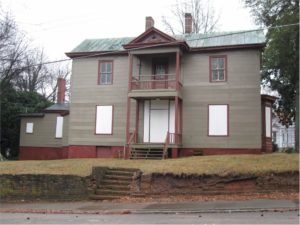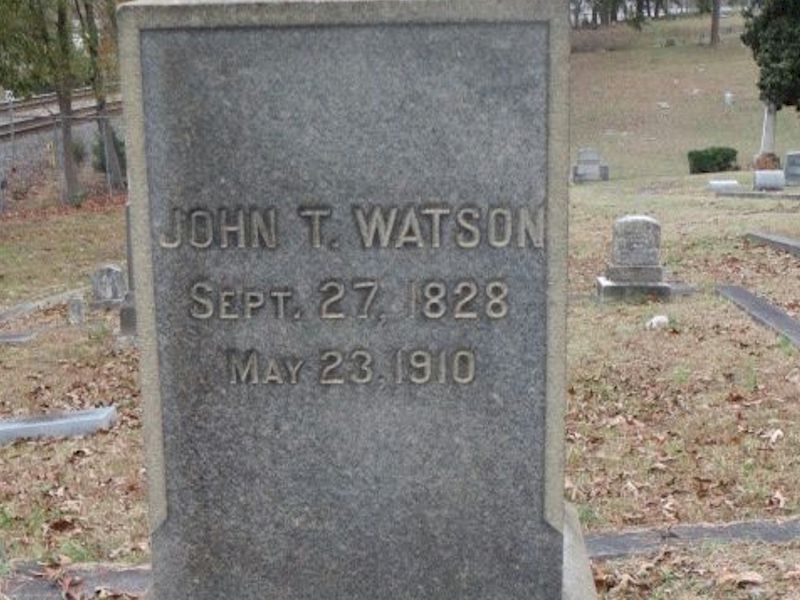John Thomas Watson was born in 1828, the eldest of ten children of Alanson Lee Watson and Emily Elizabeth Yarborough Watson. Emily was the granddaughter of Revolutionary War hero Captain Benjamin Merrill, a “pioneer of North Carolina” captured by the British in 1777 and executed for treason.
In 1847, John Thomas Watson, or J. T., came to Danville to practice law. Ten years later, he married Anne Green Read, sister to Clara Read and daughter to George Whitfield Read, whom we’ve discussed in a previous post. In the 1860 Census, J. T. appears with historically significant Danvillians such as W.T. Sutherlin, Levi Holbrook, George W. Read, and Thomas Doe.
 J. T. Watson owned a good bit of property, mostly on Pine Street, including the house he built at 899 Pine Street in the point with Chestnut Street (now known as 125 Chestnut Street). If he was not living in that house in 1860, he was nearby. He and Anne had three children together, Charlotte Elizabeth (b. 1858), George Alanson (b. 1859, pictured right), and John Thomas Watson, Jr. (b. 1861). Two years later, Anne passed.
J. T. Watson owned a good bit of property, mostly on Pine Street, including the house he built at 899 Pine Street in the point with Chestnut Street (now known as 125 Chestnut Street). If he was not living in that house in 1860, he was nearby. He and Anne had three children together, Charlotte Elizabeth (b. 1858), George Alanson (b. 1859, pictured right), and John Thomas Watson, Jr. (b. 1861). Two years later, Anne passed.
During the war, Mr. Watson served in the Confederate Army, but when his skills with machines was discovered he was assigned to the magazine service. There he helped to manufacture arms and ammunition. On his return from service, J. T. married Anne’s cousin, Sarah Edmunds Read in 1866, and two more children were born to the family; Henry Embra Scott Watson in 1868 and Clement Read Watson in 1870.
Though Mr. Watson started as a lawyer, he was associated with several other Danville enterprises. Among these was Danville’s first coal business. He had a major hand in establishing the Piedmont Railway, which later became part of the Richmond and Danville Railroad and then the Southern Railway. He was also associated with several business ventures alongside William T. Sutherlin. In 1873 the founded the John T. Watson Brick Company. In his later years he was president of the hardware company, Hodnett-Vass-Watson Co.
In 1909, an aging J. T. took a tumble from his Pine Street front porch and broke his hip. Though described as “a man of wonderful physique and vitality” he never recovered. In 1910, after a sudden and rapid decline, he passed away at his home at the corner of Chestnut and Pine Streets.
John T. Watson, Jr. clearly inherited his father’s business savvy. By the age of 18 he was working as a clerk in a warehouse. For a time, John, Jr. was living in Richmond, but by 1908 he had returned to take over his father’s brick yard. He and his wife, Mary Verser Green, took up residence at 125 Sutherlin Avenue. It was around this time that Watson Street was named after the father and son who had a brick enterprise near the Dry (railroad) Bridge on South Main Street. Eventually the brick enterprises of Watson and Fitzgerald united to form the Watson-Fitzgerald Brick Corporation with offices located at 115 Watson Street by 1927. Young John Watson also followed his father’s footsteps in the hardware trade when he became president of the Hodnett-Vass-Watson Company in 1919, eventually becoming Swain-Watson Company and then Link-Watson.
It was John T. Watson, Jr. who donated the land for the original Sunnyside Home “for aging ladies’ at 350 Virginia Avenue until Alice S. Burton donated her Main Street home.
There is an amusing anecdote involving J.T.’s father, (John T. Jr.’s grandfather, A.L. Watson): In 1847, Alanson Lee (or A. L.) Watson, a mason and plasterer who, by 1827, first relocated to Lexington, North Carolina. Twenty years later, A. L., by then “very stout, with thick neck and large abdomen” would stumble into a nearby Charlotte hotel, smelling of liquor and leaning heavily upon the reception counter.
 “Although a man of much respectability and good standing,” the notice in the Charlotte Observer read, “he occasionally spreed and was drinking yesterday when he came into the hotel and registered his name, leaning over the register in a peculiar manner, the cause of which was supposed at the time to be intoxication. … In a few moments after he sat down at the table a gentleman sitting near observed him making a blowing noise from his mouth; foam collected on his lips, and he would have fallen from his chair had not assistance been prompt. While being carried to a room his face turned black and only then was it fully realized that the man was dying.”
“Although a man of much respectability and good standing,” the notice in the Charlotte Observer read, “he occasionally spreed and was drinking yesterday when he came into the hotel and registered his name, leaning over the register in a peculiar manner, the cause of which was supposed at the time to be intoxication. … In a few moments after he sat down at the table a gentleman sitting near observed him making a blowing noise from his mouth; foam collected on his lips, and he would have fallen from his chair had not assistance been prompt. While being carried to a room his face turned black and only then was it fully realized that the man was dying.”
Going back yet another generation, Alanson’s father, John Henry Watson was born in Scotland in 1780 and arrived in the new Unites States when he was about three years old. The family settled in Pittsylvania County where they appear on the earliest census there. John Henry Watson married Elizabeth Green and had three children, Caroline Watson (b. 1805), Alanson Lee Watson (b. 1808), and William Baragrove Watson (b. 1811). Shortly after the passing of his wife in 1837, John Henry Watson left the Pittsylvania farm and came to Danville. Here he became the caretaker of Grove Street Cemetery.
Legend has it that John Henry Watson caught a robber who had stolen a sum of money and buried it for safe keeping in his girlfriend’s grave. When the robber returned to get it, John Henry apprehended him. The bank recovered the stolen money. When grandfather Watson died in 1860, he was buried near the robber’s girlfriend’s grave, where he could watch over her for eternity. An anonymous donor erected John Henry’s headstone. It reads, “In memory of John H. Watson, Died Oct 30, 1860, 80 Ys. 1 Mo. 26 D’s. A sinner saved by Grace. By: A Friend.”
Sources:
History of North Carolina; Joseph Grégoire de Roulhac Hamilton, Robert Digges Wimberly Connor, William Kenneth Boyd; Lewis Publishing; 1919
Find-a-Grave
The Charlotte Observer; Charlotte, North Carolina; 8 May 1880, pg. 3
The Charlotte Democrat; Charlotte, North Carolina; 14 May 1880, pg. 3
The Danville Register; Danville, Virginia, “Mr. John T. Watson: Aged Resident Dies After Long Illness“, May 1910
If Streets Could Talk, Lee Wayland, 2011
Census and Vital records at Familysearch.org
Census, directory, and other information gathered by Paul Liepe
